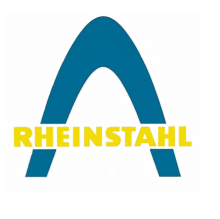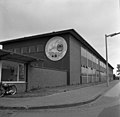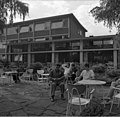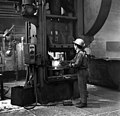Rheinstahl

The Rheinische Stahlwerke AG ( Rheinstahl group) was a company in the steel industry as well as mechanical and plant engineering .
history
From the foundation to 1918
The foundation stone of the company was laid in 1870 when Barthold Suermondt founded the Société Anonyme Aciéries du Rhin in Paris , which was renamed Rheinische Stahlwerke in 1872 . Suermondt appointed his son William Suermondt and his cousin George Octave Pastor as technical directors . In 1879, through the mediation of the new technical director Gustave Léon Pastor , a brother of George Oktave and, since 1878, his successor, both for the Rheinische Stahlwerke and for the Hörder Bergwerks- und Hütten-Verein , which so far both have followed the Bessemer processes worked to be the first to acquire a license from Sidney Gilchrist Thomas for the new Thomas process on German customs territory . This innovation, but also the distribution of sub-licenses, led to a rapid increase in the company over the next 15 years during the term of patent protection. For this, the Rheinische Stahlwerke were honored with the silver state medal at the Rheinisch-Westphalian industrial and commercial exhibition in Düsseldorf in 1880. In 1881/1882 a new rail rolling mill was built on which rails up to 20 m long could be rolled out in one piece, the workforce amounts to 1331 people. In the same year the Minette (ore) mine in Alringen in Lorraine was acquired in order to gain access to ores for the Thomas process. (Because of the high freight costs by rail, however, the ore was only actually used in its own converter from 1901 onwards.)
In Duisburg , an integrated steelworks was built in 1884/1885 with the construction of a Siemens-Martin steelworks and in 1887/1888 two blast furnaces ; in 1891, 2,100 people work at the Rheinische Stahlwerke. A third blast furnace was built as early as 1896/1897 and, through the acquisition of the Zeche Centrum in 1899/1900, a mine was added to the iron and steel processing plants, the workforce grew from 3843 to 7387. In 1903/1904 the Duisburg iron and steel works were opened in Meiderich with around 1500 employees and thus expanded the product range towards more sophisticated products. In 1904 and 1908 a fourth and a fifth blast furnace are built - pig iron production is increased to 400,000 t / a. In 1910/1911 the Ilsenburger Hütte is acquired and closed shortly afterwards in order to transfer the participation figures of the steelworks association to the Duisburger Stahlwerke. In 1911/1912 the processing capacities are expanded again with the purchase of the Vereinigte Walz- und Röhrenwerke AG - the workforce grows to 11,697 people.
1918-1945
In 1922, the Arenbergsche AG for mining and smelting operations merged with the Prosper colliery to form the Rheinische Stahlwerke. Furthermore, in 1924 an interest group was formed with IG Farben , which existed until 1945. The goal of the interest group was to secure the coal needs of IG Farben.
In 1926, Rheinische Stahlwerke AG brought its ore mines and steel operations into the newly founded Vereinigte Stahlwerke AG , but continued to own the coal mine and trade in coal. In return for bringing in the stakes, the company received a stake in Vereinigte Stahlwerke AG. Until the end of the war, Rheinische Stahlwerke AG was one of the major shareholders of the steel group.
After 1945
In the unbundling of the United Steelworks after the Second World War, Rheinstahl retained the mines as well as the processing companies in the form of Rheinstahl Union Maschinen- und Stahlbau AG as well as holdings in Ruhrstahl AG with Henrichshütte , Rheinisch-Westfälische Eisen- und Stahlwerke AG in Essen as well as the Bochum association . Rheinstahl's stake in IG Farben was converted into a majority stake in Dynamit Nobel , which had merged into IG Farben , as a result of the unbundling . Rheinstahl sold this majority stake to Friedrich Flick in 1959 . The group was significantly expanded again in 1952 with the takeover of Hanomag and in 1964 with the purchase of the Kassel Henschel works . The truck divisions of the two companies were merged into Hanomag-Henschel Fahrzeugwerke GmbH (HHF) in 1969 and taken over by Daimler-Benz AG in 1971 .
At the end of the 1960s, however, the Rheinstahl Group ran into financial difficulties that could not be significantly changed even through a restructuring in the early 1970s. On February 21, 1973 it was then mutually announced that August Thyssen-Hütte AG (ATH) was seeking a majority stake in Rheinstahl AG - as early as March 14, 1973, the majority of the shares were owned by ATH. The processing and mechanical engineering operations were transferred to Rheinstahl AG, and steel production was transferred to August Thyssen-Hütte. In the course of 1976 the name "Rheinstahl" was then given up and the entire group was merged under the new trademark, consisting of the Rheinstahl arch and the Thyssen logo.
The Rheinstahl Union Brückenbau AG in particular became known through structures such as the Aswan Dam in Egypt and the Zoobrücke in Cologne.
today
The sub-companies of the Rheinstahl group that still exist today belong accordingly to ThyssenKrupp , and the company logo of the former Rheinstahl group, the so-called Rheinstahl-Bogen, still forms part of the ThyssenKrupp AG logo today.
The former corporate headquarters in Essen's southern district to the west of the main train station directly on the south side of the railway line housed the headquarters of the ThyssenKrupp “Technologies” division, but is now empty.
The former administration building of the Rheinische Stahlwerke, Haus Ruhrort , is located in Duisburg- Ruhrort .
The name Rheinstahl lives on today in the legal, non-profit “Rheinstahl Foundation”, which has been awarding scholarships to motivated, volunteer students in engineering, economics and MINT subjects since it was founded in 1960.
gallery
Subsidiaries
- North Sea Works from 1957, shipyard ( MS Rheinstahl )
literature
- Alexander Donges: The United Steel Works AG under National Socialism. Group policy between market economy and state economy. Series: Family - Company - Public: Thyssen in the 20th Century, Vol. 1. Verlag Ferdinand Schöningh, Paderborn 2014, ISBN 978-3506766281 .
- Helmut Uebbing: Paths and waymarks . 100 years of Thyssen. Siedler, Berlin 1991, ISBN 3-88680-417-8 . (in particular chapter "Rheinstahl acquisition")
- Wilfried Feldenkirchen: "Die Eisen- und Stahlindustrie des Ruhrgebiets 1879-1914", Franz Steiner Verlag Wiesbaden 1982, in particular the time table p. 347 ff. And workforce figures in table 104a
- Manfred Rasch: Söhngen, Werner. In: New German Biography (NDB). Volume 24, Duncker & Humblot, Berlin 2010, ISBN 978-3-428-11205-0 , p. 527 f. ( Digitized version ).
Web links
- Early documents and newspaper articles on Rheinstahl in the 20th century press kit of the ZBW - Leibniz Information Center for Economics .
Individual evidence
- ↑ top v .: "Dynamit Nobel - vom Lack zu Flick", in: Der Spiegel , 29/1965, July 14, 1965 online (accessed on August 24, 2010)
- ↑ The company logo Official website ThyssenKrupp on the creation of the company logo
- ^ Rheinstahl Foundation. Retrieved April 20, 2019 .





